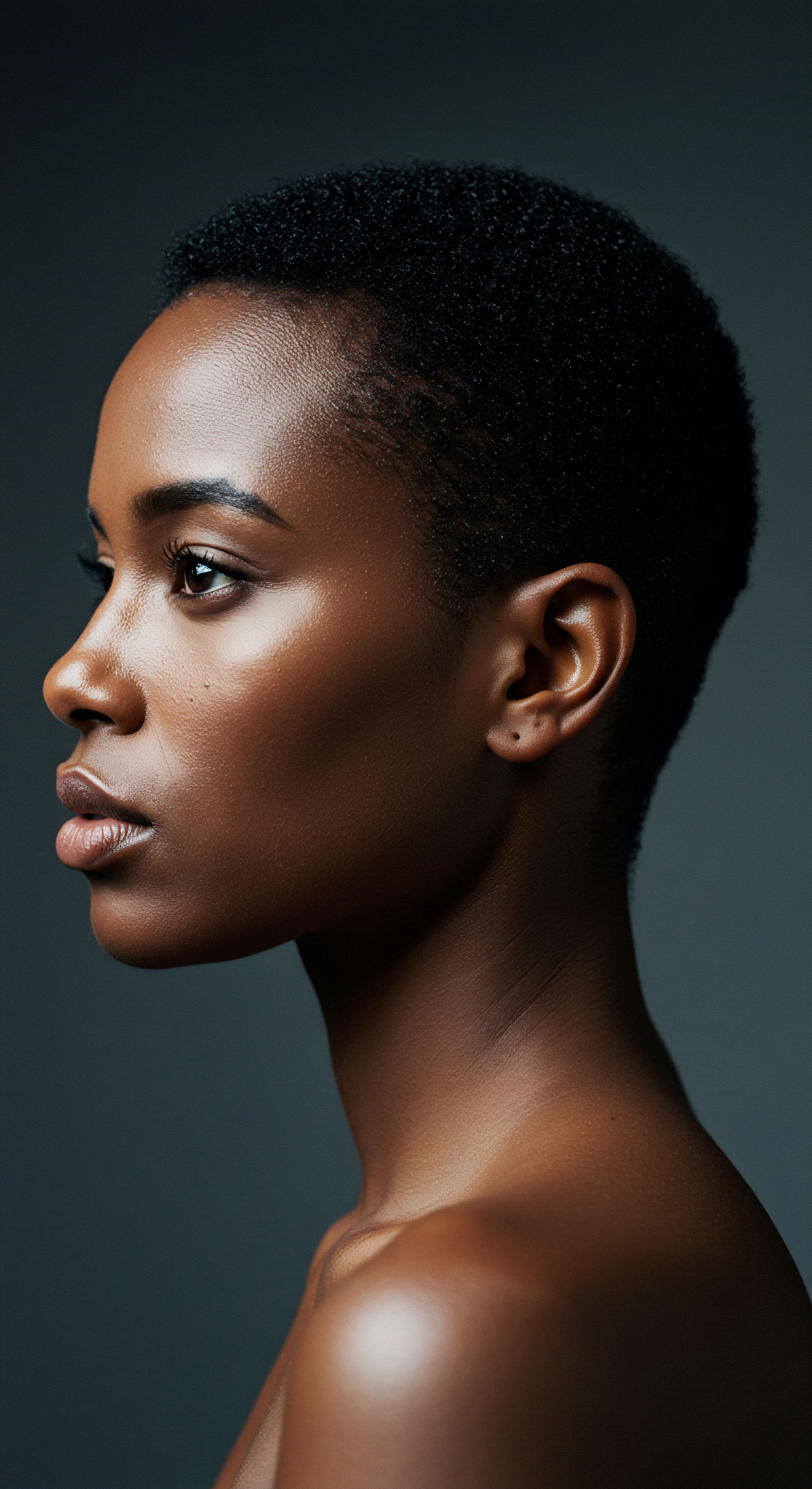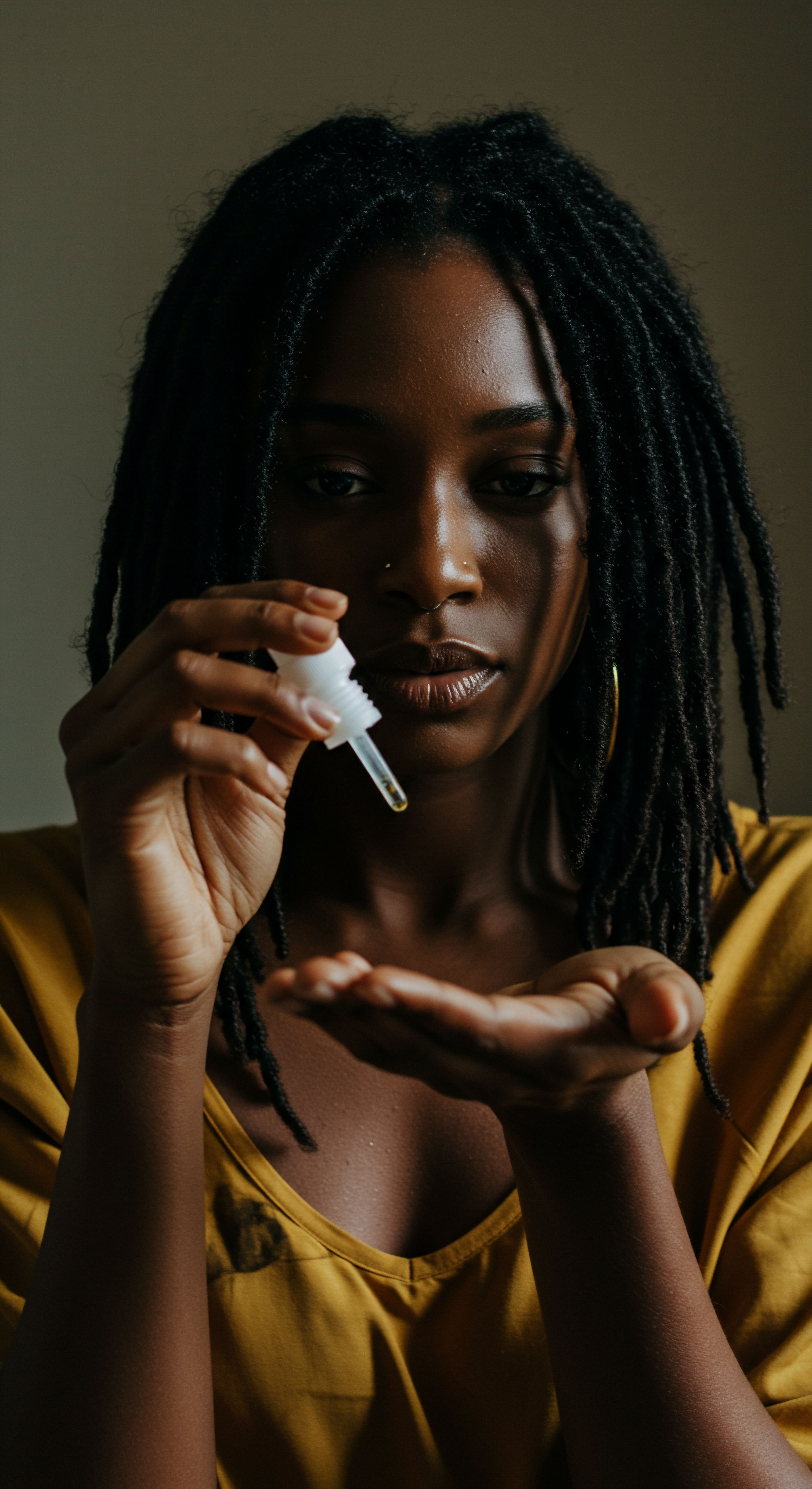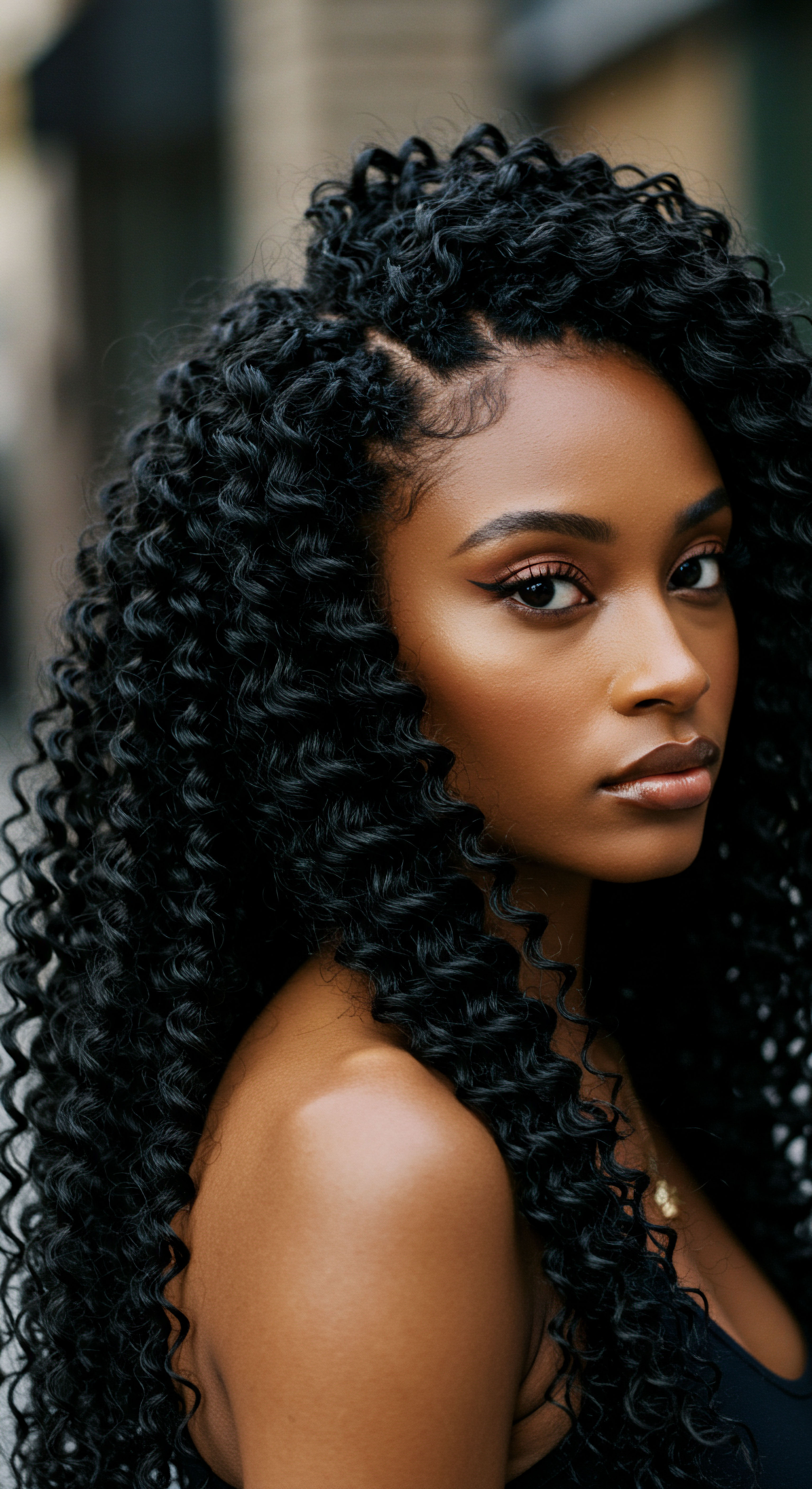
Roots
The quiet hours of slumber, often perceived as a period of stillness and restoration, hold a profound significance for the delicate architecture of textured hair. Beyond the surface understanding of rest, there lies a deep connection to ancestral wisdom, a quiet echo of practices honed over generations to safeguard strands through the night. Our exploration begins at the very foundation of this understanding, delving into the unique characteristics of textured hair and the environmental realities that have shaped its care across cultures. This journey into the elemental aspects of hair preservation during sleep uncovers not merely techniques, but a philosophy of protection born from intimate knowledge of hair’s inherent nature.

The Unique Architecture of Textured Hair
Textured hair, encompassing a spectrum from waves to coils, possesses a distinct structure that sets it apart. Unlike straight hair, which tends to have a more circular cross-section, coily strands often exhibit an elliptical or even flat shape. This varied geometry, paired with fewer cuticle layers, means that each bend and curve along the hair shaft becomes a potential point of vulnerability. These natural formations, while beautiful, render textured hair more susceptible to mechanical damage, particularly from friction.
The cuticle, serving as the hair’s outermost shield, comprises overlapping scales. When these scales are lifted or disturbed, the hair becomes prone to moisture loss and breakage. This inherent structural quality underscores the importance of mindful handling, especially during periods of unconscious movement, such as sleep.
Textured hair, with its unique elliptical shape and fewer cuticle layers, is particularly susceptible to mechanical damage from friction.
Understanding the hair’s fundamental design helps explain why ancestral communities placed such emphasis on nightly preservation. The recognition that sleep, a time of unconscious shifting and rubbing, could compromise hair integrity was not merely anecdotal; it was a deeply observed truth. The hair’s natural oils, which struggle to travel down the curved shaft as easily as on straight strands, also mean textured hair can lean towards dryness, further increasing its fragility against abrasive surfaces. This predisposition to dryness and mechanical stress has historically guided the development of protective sleep practices.

Hair’s Nocturnal Challenges
The night, for textured hair, presents a unique set of challenges. The average person shifts positions multiple times during sleep, creating constant contact and friction between hair and bedding materials. Cotton pillowcases, while comfortable, are known for their absorbent properties and fibrous texture. This combination can draw moisture from the hair, leaving it drier, and simultaneously create microscopic snags that roughen the cuticle.
The result is often increased tangling, frizz, and ultimately, breakage. This dynamic, though unseen, works against the hair’s natural resilience, particularly for types that already experience dryness and fragility.
Ancestral communities, without modern scientific instruments, understood these effects through keen observation and generations of accumulated wisdom. They perceived the morning state of hair – the tangles, the dryness, the diminished luster – as direct evidence of the night’s toll. This experiential knowledge formed the basis for developing solutions that offered a shield against these nightly aggressions. The protective measures were not just about aesthetics; they were about preserving the health and longevity of hair, which held deep cultural and social significance.

A Comparative Glance at Hair Structures
To fully appreciate the ancestral wisdom, consider the fundamental differences in hair structure.
| Hair Type Straight Hair |
| Cross-Section Shape Circular to slightly oval |
| Cuticle Layering More uniform, compact |
| Moisture Retention Generally higher |
| Hair Type Wavy Hair |
| Cross-Section Shape Oval |
| Cuticle Layering Slightly less uniform |
| Moisture Retention Moderate |
| Hair Type Curly Hair |
| Cross-Section Shape Elliptical |
| Cuticle Layering Less uniform, more lifted points |
| Moisture Retention Lower, prone to dryness |
| Hair Type Coily Hair |
| Cross-Section Shape Flat to highly elliptical |
| Cuticle Layering Fewer, often lifted layers |
| Moisture Retention Lowest, most prone to dryness |
| Hair Type This table highlights the structural distinctions that influence hair's vulnerability during sleep. |
The variances in shape and cuticle integrity across hair types explain why a universal approach to nighttime hair care falls short. Ancestral practices, particularly those from communities with predominantly textured hair, reflect a profound understanding of these intrinsic qualities. They recognized that protecting hair during sleep required a different approach than simply keeping it clean or styled for the day. It demanded a shield, a cocoon, a method to minimize friction and preserve the precious moisture that textured strands naturally seek to hold.

Ritual
Stepping from the foundational understanding of hair’s structure into the realm of applied wisdom, we find the ancestral rituals that transformed nightly care into a purposeful act of preservation. This segment acknowledges the reader’s desire for practical insight, moving beyond the inherent qualities of textured hair to the deliberate actions taken to safeguard it during sleep. It feels akin to entering a shared space of practical knowledge, where techniques and methods unfold with gentle guidance. These practices, passed down through generations, offer a profound blueprint for shielding textured hair, turning a simple act of going to bed into a restorative ceremony.

The Art of Hair Cloaking
One of the most widely recognized ancestral practices involves the cloaking of hair before slumber. This is not merely about covering the hair; it signifies a conscious act of protecting delicate strands from the harsh realities of friction and moisture loss that a night’s rest can bring. Across various cultures, materials such as silk, satin, and even tightly woven cotton or linen have been employed. The choice of material was often dictated by local availability and the understanding of its properties.
Silk and satin, with their smooth surfaces, minimize friction, allowing hair to glide rather than snag, thereby reducing breakage and preserving the hair’s natural moisture. Historical accounts point to the widespread use of such coverings in various societies, from elaborate head wraps in West African communities to the delicate silk bonnets of East Asian nobility.
These head coverings served multiple purposes ❉ they kept intricate hairstyles intact, shielded hair from environmental dust and debris, and crucially, provided a barrier against the abrasive nature of sleeping surfaces. The act of wrapping or covering hair became a nightly custom, deeply embedded in daily routines, a silent acknowledgment of hair’s vulnerability and value.
Ancestral hair cloaking, using smooth materials, offers a vital shield against friction and moisture depletion during nightly rest.

Choosing the Right Nocturnal Fabric
- Silk ❉ Revered for its smooth protein structure, silk reduces friction and helps retain hair’s natural oils. It is gentle on the cuticle, minimizing tangles and breakage.
- Satin ❉ A synthetic alternative to silk, satin also offers a smooth surface that reduces friction. It is often more accessible and provides similar protective benefits for hair.
- Fine Cotton/Linen ❉ While generally more absorbent than silk or satin, certain tightly woven, smooth cottons or linens were historically used, particularly when silk was not readily available. Their effectiveness relied on regular conditioning of the hair to offset moisture absorption.

Protective Styling for Night
Beyond external coverings, ancestral practices also included specific ways of styling hair for sleep that minimized tension and prevented tangling. These protective styles, often braids or twists, served to gather the hair, reducing its exposure to friction and keeping strands aligned. For textured hair, which naturally tends to coil and intertwine, leaving it loose during sleep can lead to significant knotting and matting. By gently securing the hair, these styles offered a compact and resilient form, ready to withstand the night’s movements.
In many African and diasporic communities, practices like braiding or twisting hair into sections before bed were common. These styles, often secured loosely at the nape of the neck or on top of the head, prevented the hair from spreading out and rubbing against the pillow. This approach not only preserved the hair’s condition but also helped maintain the definition of curls and coils, making morning styling more manageable. The careful placement of braids or twists, avoiding excessive tightness, was also crucial to prevent tension on the scalp, a practice that aligns with modern understanding of avoiding traction.

Common Protective Nighttime Styles
- Loose Braids ❉ Creating one or several loose braids, especially a single braid at the nape, helps keep strands together and reduces surface area exposed to friction.
- Pineapple Method ❉ Gathering hair into a high, loose ponytail or bun on top of the head minimizes contact with the pillow for longer hair.
- Twists ❉ Similar to braids, two-strand twists or flat twists keep hair neatly contained, reducing tangles and preserving curl pattern.

The Role of Oils and Butters
The application of natural oils and butters before bed was another widespread ancestral practice. Communities rich in resources like shea butter, coconut oil, or various plant-derived oils understood their capacity to seal in moisture and add a layer of protection to the hair shaft. This pre-sleep oiling ritual was not merely for cosmetic shine; it was a practical defense against the dehydrating effects of night air and absorbent bedding.
A light coating of oil or butter on the hair before it was covered or styled for the night created a smoother surface, further reducing friction. It also provided a continuous, gentle conditioning treatment, ensuring the hair remained supple and less prone to breakage. This holistic approach, combining external coverings with internal conditioning, speaks to a deep, intuitive understanding of hair’s needs. The ritual of warming the oil, perhaps infusing it with herbs, and gently massaging it into the scalp and strands before bed, also added a calming, sensory dimension to the nighttime routine, promoting relaxation and well-being.

Relay
This section ventures into the most sophisticated and multi-dimensional exploration of ancestral sleep practices for textured hair. We pose a deeper, reflective sub-question, inviting a profound insight where science, culture, and intricate details converge. The intellectual stimulation here remains grounded in Roothea’s characteristic warmth and accessibility. This is where the wisdom of generations meets contemporary understanding, where the whispers of the past find resonance in the data of the present, allowing for a profound understanding backed by scholarly inquiry.

How Do Material Properties Impact Hair Integrity During Sleep?
The choice of sleeping surface, and particularly the fabric of pillowcases and head coverings, plays a far more significant role in hair health than often considered in contemporary discussions. Ancestral communities, through generations of observation, arrived at conclusions that modern material science now affirms. The very structure of fibers, their coefficient of friction, and their moisture absorption capabilities directly influence the mechanical stress placed upon hair during nightly movement.
Cotton, for instance, possesses a relatively high coefficient of friction, meaning it creates more resistance when hair rubs against it. Its absorbent nature further exacerbates this by drawing moisture from hair strands, leaving them dry and more vulnerable to mechanical abrasion.
In contrast, silk, a natural protein fiber, exhibits a remarkably low coefficient of friction. This smooth surface allows hair to glide effortlessly, significantly reducing the mechanical wear and tear on the cuticle. A study published in the Journal of Cosmetic Science by Bhushan et al. (2014) on the “Friction Dynamics of Straight, Curly, and Wavy Hair” highlighted that curly and wavy hair types experience greater friction than straight hair due to their more numerous contact points.
This research underscores why smooth, low-friction materials like silk or satin are particularly beneficial for textured hair, as they mitigate the inherent vulnerability of its complex structure to mechanical stress during sleep. This scientific validation provides a compelling, data-backed reason for the ancestral preference for smooth coverings. The wisdom of choosing specific materials was not merely about comfort or luxury; it was a practical, protective measure against the invisible forces of nightly friction.

The Microscopic Dance of Hair and Fabric
Consider the hair cuticle, a protective outer layer akin to shingles on a roof. When hair rubs against a rough surface, these shingles can lift, chip, or even break. This damage leads to frizz, tangles, and ultimately, breakage. The average person shifts positions up to 40 times each night, creating repeated instances of this damaging friction.
The weight of the head, approximately 10 pounds, concentrated on a small area of hair during these movements, compounds the issue. This constant, subtle mechanical stress, accumulating over hours, explains why hair can appear disheveled and damaged upon waking. Ancestral practices like wearing silk or satin head wraps or sleeping on smooth surfaces directly counteracted this microscopic assault, creating a buffer zone for the hair.

Do Nighttime Protective Styles Influence Scalp Health and Hair Growth Cycles?
The relationship between nighttime hair practices and overall scalp health, including hair growth cycles, extends beyond mere physical protection. Ancestral methods often integrated scalp care into nightly routines, recognizing the scalp as the foundation for healthy hair. Practices such as gentle scalp massage, often performed with nourishing oils, aimed to stimulate blood circulation. Modern science confirms that adequate blood flow to the scalp ensures hair follicles receive essential nutrients and oxygen, which are vital for healthy hair growth.
However, there is a nuanced aspect to consider regarding tension. While protective styles are beneficial, excessive tightness can lead to a condition known as traction alopecia, a preventable form of hair loss resulting from prolonged tension on hair follicles. A study on “Techniques Used for Hair Style Maintenance while Sleeping May Be a Risk Factor for Traction Alopecia” by Callender et al. (2021) in the Journal of the National Medical Association points out that while silk scarves and bonnets are advocated, tight-fitting head wraps or overly tight styles at night can contribute to traction alopecia in susceptible individuals.
This suggests that the ancestral emphasis on loose protective styles and gentle wrapping was not only intuitive but also scientifically sound, preventing a common yet often overlooked form of hair loss. The balance between protection and tension is a delicate one, a lesson embedded within the successful continuation of these age-old customs.
The wisdom of ancestral practices lay in their intuitive understanding of this balance. They knew that a style should be secure enough to contain the hair but never so tight as to cause discomfort or stress to the scalp. This careful application allowed the hair follicles to remain undisturbed, supporting their natural growth cycle, rather than hindering it through constant pulling. The integration of oils during these nighttime routines also provided a soothing effect, further contributing to a healthy scalp environment conducive to growth.
The careful balance of protection and tension in ancestral nighttime styles is validated by modern research on traction alopecia.

The Psychosocial and Cultural Dimensions of Nocturnal Hair Care
Beyond the physiological benefits, ancestral nighttime hair practices carried profound psychosocial and cultural weight. Hair, across many societies, has always been more than just a physical attribute; it is a symbol of identity, status, spirituality, and community. The nightly ritual of hair care, often a communal activity among women, served to reinforce familial bonds and transmit cultural knowledge from elder to younger generations. This shared experience transformed a utilitarian act into a moment of connection, storytelling, and cultural preservation.
In many African communities, the preparation of hair for sleep was an intimate, intergenerational exchange. Grandmothers, mothers, and aunts would share techniques, wisdom, and stories while braiding or oiling hair. This provided not only physical protection for the hair but also emotional nourishment and a sense of belonging.
The quiet act of preparing hair for rest became a conduit for passing down heritage, reinforcing cultural values, and ensuring the continuity of traditions. The protective styles worn at night were often a continuation of daytime styles, ensuring that the hair remained a reflection of identity even during unconscious hours.
The very act of protecting hair, seen as a sacred part of the self, also contributed to a sense of self-worth and pride. This holistic perspective, where physical care intertwined with social and spiritual well-being, highlights the comprehensive nature of ancestral wisdom. The nightly routine was not an isolated task but a thread in the larger tapestry of life, connecting individuals to their lineage and their community. This cultural contextualization deepens our understanding of why these practices persisted and continue to hold relevance today.

Reflection
As the quiet hush of night descends, and the world prepares for rest, the enduring wisdom of ancestral hair practices offers a gentle whisper. It reminds us that care for our textured strands extends beyond the daylight hours, reaching into the stillness of slumber. The journey through these time-honored methods reveals a profound respect for hair’s inherent nature, a recognition of its delicate strength, and an intuitive understanding of how to shield it from the unseen stresses of the night.
From the selection of smooth coverings that cradle each coil to the deliberate crafting of protective styles that guard against tangles, these practices are not relics of a distant past. They are living blueprints, offering a path to nurture our hair with purpose and tenderness, ensuring it awakens refreshed and resilient, ready to greet the new day.

References
- Bhushan, B. et al. (2014). Friction Dynamics of Straight, Curly, and Wavy Hair. Journal of Cosmetic Science, 65(4), 213-228.
- Callender, V. D. et al. (2021). Techniques Used for Hair Style Maintenance while Sleeping May Be a Risk Factor for Traction Alopecia. Journal of the National Medical Association, 113(1), 81-86.
- Charaka Samhita. (c. 1st Century CE). (Ancient Indian text on Ayurvedic medicine).
- Wong, N. Williams, K. Tolliver, S. & Potts, G. (2025). Historical Perspectives on Hair Care and Common Styling Practices in Black Women. Cutis, 115(3), 95-98.
- Synnott, A. (1987). Shame and Glory ❉ A Sociology of Hair. British Journal of Sociology, 38(3), 381-413.